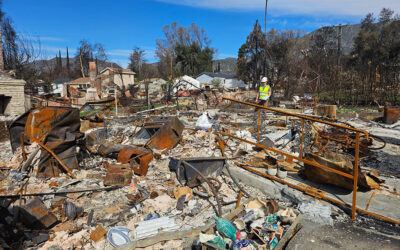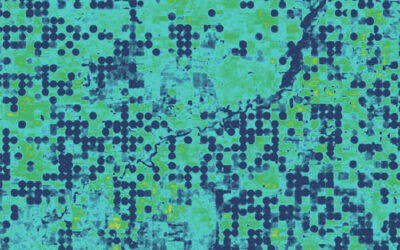This summer and fall, DRI brought twelve students from Nevada’s community and state colleges to the Las Vegas and Reno campuses for a paid, immersive research experience. Over the course of the 16-week program, students worked under the mentorship of DRI faculty members to learn about the process of using scientific research to solve real-world problems. This unique internship program welcomes all students, not only those pursuing majors in science, who are in their first or second year of enrollment at local state and community colleges.
Students for the 2024 fall semester joined from the College of Southern Nevada, Nevada State University, Truckee Meadows Community College, and the University of Nevada-Reno.
“The Research Immersion Internship program has created 62 semester-long internships at DRI since 2021,” says Meghan Collins, M.S., who leads the internship program. “These students continue to impress us with their dedication to science and interest in learning new things. The impact of the program on students is significant: they report to us that they come away with more confidence to take the next step in their careers in STEM, and they gain valuable skills in problem-solving using the tools of science and technology.”
The students wrapped up their semester-long internships on Dec. 12th by presenting lightning talks about their research to the DRI community. Their research spanned multiple scientific disciplines, from helping households manage air quality during wildfires, to assessing ecosystem recovery following a wildfire, to beta testing an app focused on fostering community engagement for environmental events.
Applications for summer 2025 internships will open in spring 2025.
Project: Understanding the Litter Under the Surface of Lake Tahoe Beaches
Student Researchers: Rachel Eves, Sabbathiel Greene, Lauren Broncho, Melanie Paz-Flore
Faculty Mentors: Angelique DePauw, Graduate Student in the Microplastics and Environmental Chemistry Lab, Daniel Saftner, Assistant Research Hydrogeologist, and Monica Arienzo, Associate Research Professor of Hydrology
Known as one of the premier tourist destinations on Earth, nearly 15 million people visit Lake Tahoe every year. Along with serving as a vacation destination, the lake also acts as the primary source of water for communities within its watershed. Unfortunately, high visitation brings challenges for managing beach litter, which often makes its way into the lake’s waters. Monica Arienzo has been studying microplastics in the lake since 2018 and has expanded her research to the watershed’s beaches and mountain snowpacks in an effort to identify how microplastics are reaching the lake.
Interns Rachel Eves, Sabbathiel Greene, Lauren Broncho, and Melanie Paz-Flore joined Arienzo, along with lab mates Dan Saftner and Angelique DePauw, during summer 2024. Their project teamed up with Eco-Clean Solutions, a local nonprofit that created an innovative litter cleaning robot that combs Tahoe beaches. The interns gathered litter collected by the robot, known as BEBOT, and sorted through the material to identify the source. They categorized litter from seven Tahoe beaches, including Zephyr Cove and King’s Beach, and found that plastic accounted for 44-63% of the individual pieces of litter. To account for possible differences between the busy summer season and the quieter months, the team conducted two separate beach litter combs and found that the tourist season resulted in higher amounts of litter.
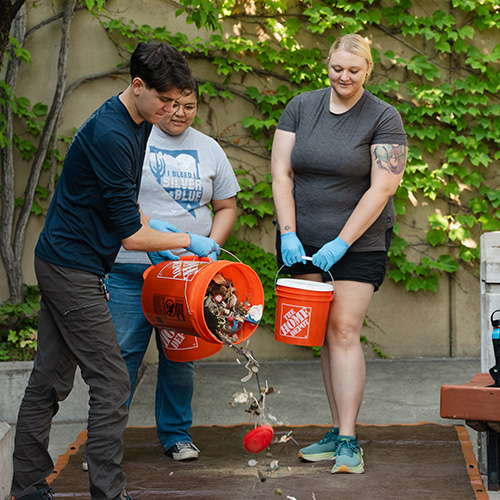
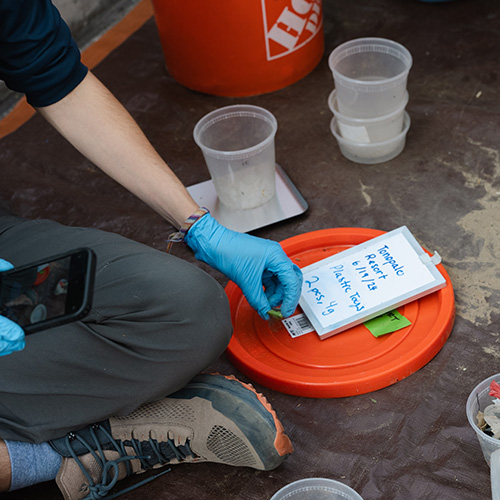
“Participating in this internship has profoundly impacted my perspective on the harm litter is creating to the ecosystem and how consumables that we find convenient will negatively impact Lake Tahoe if they are left on the beach,” said intern Lauren Broncho.
For intern Melanie Flores, who hopes to get her bachelor’s degree in environmental management, the internship served as her first insight into the research process.
“Hydrology is a fascinating sector of environmental sciences and with this experience, I can confidently say my passion for the sciences has grown more than before along with my desire to make positive changes in my life and the lives of others,” she said.
Project: Supporting Household Health Adaptation to the Compound Events of Extreme Heat and Wildfire Smoke
Student Researcher: Harley Pollard
Faculty Mentors: Yeongkwon Son, Associate Research Professor of Environmental Health, and Kristin VanderMolen, Assistant Research Professor of Atmospheric Science
With Reno now known as the fastest-warming city in the nation, extreme heat is both a present and growing threat to communities. When high temperatures overlap with days where wildfire smoke fills the air, managing both problems in a way that maintains comfortable temperatures and clean air can be a challenge. Intern Harley Pollard participated in ongoing research led by DRI scientists Yeongkwon Son and Kristin VanderMolen to support healthy adaptations in Washoe County homes.
“The main issue and focus of this is understanding that when you have high smoke environments, it often comes with a high heat environment as well,” Pollard said. “The goal is to be able to educate our participants, review their health data, and discuss how to improve their situation.”
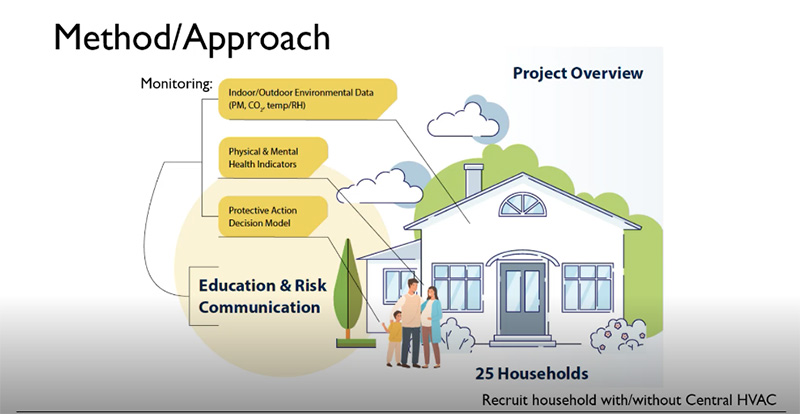
The researchers placed air quality monitors outdoors as well as inside of project participants’ homes, allowing insight into how well their current temperature control methods (central AC/window units/opening windows) protected their indoor air quality. The project recruited 18 households, some with central air conditioning and some without, and measured their physical and mental health using surveys and basic health metrics.
“I learned a lot of lessons from this internship, which was my first research experience. I learned proper research ethics, teamwork skills, and how to take and analyze data, amongst other skills,” Pollard said.
Project: Post-Dixie Fire Recovery of Camp Fleischmann
Interns: Mikayla Ward and Bryan Robbins
Faculty Mentor: Kristen O’Shea, Assistant Research Scientist and Geospatial Data Scientist
DRI scientists created Climate Engine, an innovative tool for using satellite and climate data to investigate environmental phenomenon. The user-friendly website allows researchers and other interested groups to quickly produce maps and charts to visualize datasets including temperature, precipitation, and drought assessments.
Interns Mikayla Ward and Bryan Robbins worked with DRI scientist Kristen O’Shea to look at the impacts and recovery of a boy scout camp near Lassen Volcanic National Park, Camp Fleischmann, following the large Dixie Fire in 2021. The camp has been closed indefinitely following the fire’s extensive damage, and very little recovery work has occurred, providing the research team with an undisturbed example of natural recovery post-fire. Ward and Robbins used variables like land surface temperature before and after the fire to assess recovery. Land surface temperature is a useful variable because it reflects a number of metrics that both reflect and contribute to recovery, such as soil moisture, vegetation cover, and albedo (or reflectivity of the surface).
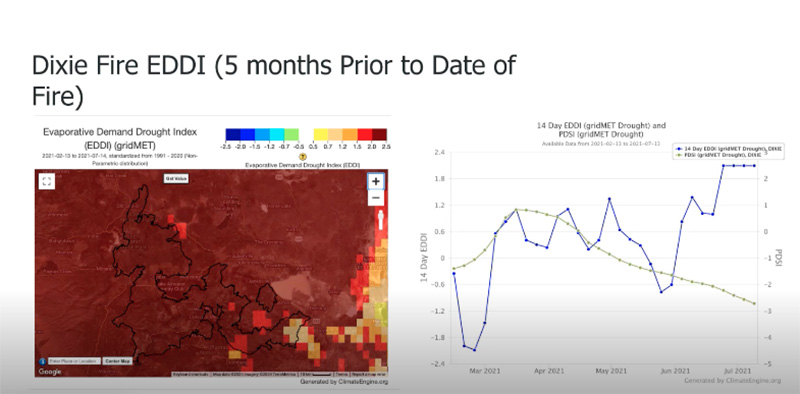
The interns also examined vegetation recovery and found that tree cover is declining each year, while understory plants are increasing. With Climate Engine’s drought data, they could also see that although the new plant life was resilient in the face of the harsh summer 2024 heat, the drought conditions are taxing vegetation across the area.
“Climate Engine offers a way for the interested public to get status updates on burned land without risking trespassing and disturbing the property or getting injured by things like falling burn snags,” Robbins said.
Project: Climu Beta Test Group
Student Researchers: Grace Smith, Gabija Stankevicius, Tatsu Narifusa, Angeles Reyes
Faculty Mentors: Justin Toller, Assistant Research Scientist and Geophysicist, and Sonia Tonino, Research Assistant and Engagement Specialist
Climu is a new platform under development that facilitates community engagement for environmental events. It allows anyone to join and promote new events and join existing events, while also incentivizing good deeds with a point system.
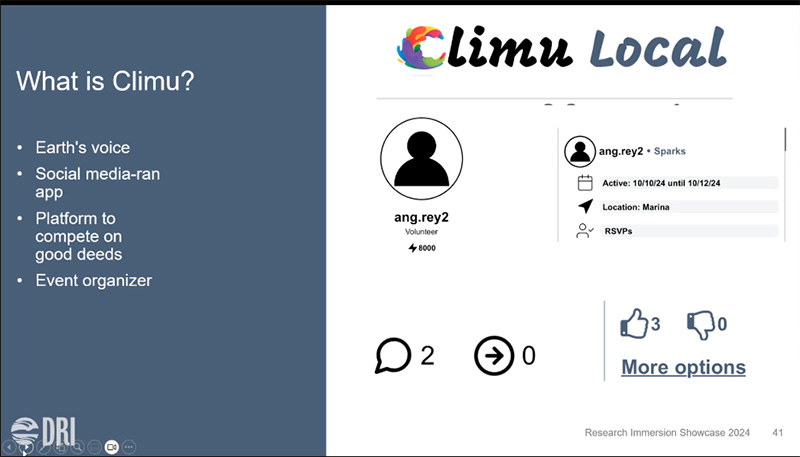
Interns Grace Smith, Gabija Stankevicius, Tatsu Narifusa, and Angeles Reyes worked with Justin Toller and Sonia Tonino to test and help prepare the platform for launch by investigating technical issues and looking for ways to promote the project with the public.
“Climu really opened up a new door for me about how we should handle climate change using modern technology,” said intern Angeles Reyes.
“Climu is about community engagement,” said intern Gabija Stankevicius. “Members could see events happening in their area, like park cleanups, or generate ideas for addressing climate concerns. It’s about reaching out to your own community and making that change within your community. I think it’s a great opportunity for younger generations, including my own peers, to start using this app and take a stance on the climate.”
The interns also learned and used coding methods to analyze data within the platform, which will help the researchers evaluate user engagement and identify areas for improvement.
“The Climu app is ready to take the next step in beta testing and will then hopefully become a helpful and commonly used platform nationwide,” said intern Grace Smith. “I can see myself and my peers using this app, because it’s very engaging and also set up in a familiar way for young people who are familiar with social media apps.”
Intern Gabija Stankevicius summarized how the internship helped develop and hone her interest in climate change and
“I entered this internship with a lot of interest in our climate, just from seeing what’s happening in our daily lives like wildfires, flooding, and hurricanes,” she said. “I feel like it’s time for the younger generation to start taking a stand, and Climu offers such an incredible opportunity to engage with people in your own community. Regular social media lacks the ability to generate action, and I think Climu is a great opportunity for the younger generation to interact with each other in a format where we can create events and start taking our own stance on the climate.”
This group of twelve interns joins the dozens who have helped DRI scientists conduct important research over the years, often choosing to continue their training in scientific fields. Some even return to DRI as graduate students working with their internship mentors. The program is an integral part of DRI’s commitment to training the next generation of scientists and fostering excellence in STEM fields for students across Nevada.
For more information about DRI’s internship programs, visit: https://www.dri.edu/immersion/
DRI’s internship is made possible thanks to the generous support of the following foundations:


